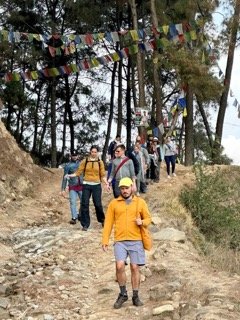Blog #5 from Jeff - Boudhanath
Boudha or Boudhanath is a uniquely sacred place of great magic and mysticism. The stupa is on the ancient trading route from Tibet where Tibetan merchants have rested and offered prayers for many centuries.
The structure itself is huge, impressive. It’s in the shape of a massive mandala making it one of the largest spherical stupas in the world. Tibetan Buddhists say the Bouda Stupa is a 3 dimensional map of liberation.
All day every day from early morning until late at night, people of every description circumambulate the stupa in a clockwise direction with their right shoulder (sacred side) closest to the structure while reciting mantras and spinning the countless prayer wheels that surround the stupa.
The prayer wheels like the colorful prayer flags that decorate the stupa have mantras written on scrolls inside them. Tibetan Buddhists believe that spinning prayer wheels, like the wind that blows through the flags, spreads the words of the mantras for the benefit of all sentient beings.
Each day of our time in Boudhanath, we met with James at 6:00 am, engaged in noble silence and meditated while circumambulating the stupa, one day focusing on our sense of sight, next day touch, next day hearing.
And multiple times daily I would find myself circling the stupa on my own, spinning the wheels while reciting the only mantra I know, so far, “Om mani padme hum, om mani padme hum” (compassion and wisdom, compassion and wisdom).
It’s lovely and very satisfying to contemplate that by simply walking around the stupa, spinning the prayer wheels and reciting mantra you could be, in even the smallest way spreading compassion and wisdom in a world so desperately in need of both. At a minimum you’re doing something that feels good to you and harms no one.
Nepal shares a lengthy border with Tibet and in the aftermath of the Chinese invasion, tens of thousands of Tibetan refugees crossed the border into Nepal and settled in Boudanath.
Today Boudanath has dozens of Tibetan Buddhists monasteries including Ka-at Ka-Nying Shedrub Ling monastey (“The White Monastery”) built in 1974 by Tulku Urgyen Rinpoche, a famous lama who left Tibet after the Chinese invasion of 1959.
Cory and James’s teachers studied at this monastery which afforded us sone exceptional opportunities.
We were invited to visit the monastery during morning puja, trekked to its affiliated nunnery and took darma teachings with Trokpa Tulku, a Khenpo (highest academic degree) at Ka-Nying monastery, student of Chokyi Nyima Rinooche, and monk in the Nyingma lineage.
Our teachings with him couldn’t have been held in a more auspicious setting with the Boudha Stupa visible through the windows behind him as he taught.
And one day, we trekked through the forests to the Nagi Gompa Nunnery where we had the singular opportunity to meet, take teachings from and have lunch with Ani Gyantara, the head nun at Nagi Gompa. She was a student of Tulku Urgyen Rinooche and also Chokyi Nyima Rinpoche and is an absolute delight.
On our way to Nagi Gompa we stopped to visit Budanilkantha, where the townspeople celebrate life cycle events. There were no weddings that day but there were several families celebrating the beginning of their son’s course of study and we witnessed the traditional celebration held when a baby has his first rice, so fun, so heartwarming!
After lunch with Ani we had a wonderful hike to a beautiful mountain monastery before returning to town to see James’s “quilt project.” James’s “quilt project” involves his funding an entire neighborhood with quilt making supplies so they can make quilts that he markets to their profit internationally. As a result of his efforts, the children in this one particular neighborhood attend school and no longer beg on the street. It was just wonderful to see the happy smiling faces of the children and families when James introduced us to them.
And in the evening at sunset, we visited Pashupatinath and witnessed the traditional ceremonies associated with another life cycle event, death and cremation.
Tomorrow we head to the Namo Buddha resort where we will have our last days of meditation yoga and hiking in the foothills of the Himalayas from where we will every morning watch the sunrise over their snow capped peaks.
What an amazing journey this spiritual pilgrimage has been!
Namaste!






